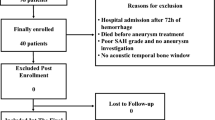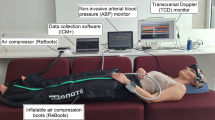Abstract
Backround
The extent of hemodynamic disturbances following subarachnoid hemorrhage (SAH) varies. We aim to determine the prognostic implications of unilateral and bilateral autoregulatory failure on delayed cerebral ischemia (DCI) and outcome.
Methods
Ninety-eight patients with aneurysmal SAH were recruited. Autoregulation was assessed using systolic flow index—Sxa. Interhemispheric difference in autoregulation was calculated to assess the spatial distribution and symmetry of autoregulatory changes. Assessment of interhemispheric difference in autoregulation in combination with overall autoregulation was used to measure the extent of autoregulatory impairment. Patients were dichotomized by the presence of DCI and 3-month mRS.
Results
Higher flow velocity and worse autoregulation (p < 0.0000001, 95 % CI 10.7–21.3 and p = 0.00001, 95 % CI 0.03–0.07 for difference in FV and Sxa, respectively) were found ipsilateral to the ischemic hemisphere or location of aneurysm (if no ischemia detected). DCI group had a higher interhemispheric difference of autoregulation than non-DCI group (p = 0.035, 95 % CI 0.003–0.08). 16/18 patients with unfavorable outcome vs. 17/72 with favorable outcome had overall poor autoregulation with low interhemispheric differences (p = 0.0013, χ 2). Unilateral autoregulatory failure was seen on a median day 3, bilateral on day 4, and vasospasm was detected on day 6.
Conclusions
Unilateral autoregulation failure was seen in patients who developed DCI (worse ipsilateral to the ischemic hemisphere). Bilateral autoregulation failure was seen more frequently in patients with unfavorable outcome. Analysis of the temporal profile showed unilateral dysautoregulation as the primary event predisposing to DCI, which in selected cases led to bilateral failure and unfavorable outcomes.




Similar content being viewed by others
References
Mayer SA, Kossoff SB. Withdrawal of life support in the neurological intensive care unit. Neurology. 1999;52(8):1602–9.
Molyneux AJ, Kerr RS, Birks J, et al. Risk of recurrent subarachnoid haemorrhage, death, or dependence and standardised mortality ratios after clipping or coiling of an intracranial aneurysm in the International Subarachnoid Aneurysm Trial (ISAT): long-term follow-up. Lancet Neurol. 2009;8(5):427–33.
Hop JW, Rinkel GJ, Algra A, van Gijn J. Case-fatality rates and functional outcome after subarachnoid hemorrhage: a systematic review. Stroke. 1997;28(3):660–4.
Budohoski KP, Czosnyka M, Smielewski P, et al. Impairment of cerebral autoregulation predicts delayed cerebral ischemia after subarachnoid hemorrhage: a prospective observational study. Stroke. 2012;43(12):3230–7.
Jaeger M, Schuhmann MU, Soehle M, Nagel C, Meixensberger J. Continuous monitoring of cerebrovascular autoregulation after subarachnoid hemorrhage by brain tissue oxygen pressure reactivity and its relation to delayed cerebral infarction. Stroke. 2007;38(3):981–6.
Jaeger M, Soehle M, Schuhmann MU, Meixensberger J. Clinical significance of impaired cerebrovascular autoregulation after severe aneurysmal subarachnoid hemorrhage. Stroke. 2012;43(8):2097–101.
Lam JM, Smielewski P, Czosnyka M, Pickard JD, Kirkpatrick PJ. Predicting delayed ischemic deficits after aneurysmal subarachnoid hemorrhage using a transient hyperemic response test of cerebral autoregulation. Neurosurgery. 2000;47(4):816–9.
Lang EW, Diehl RR, Mehdorn HM. Cerebral autoregulation testing after aneurysmal subarachnoid hemorrhage: the phase relationship between arterial blood pressure and cerebral blood flow velocity. Crit Care Med. 2001;29(1):158–63.
Pickard JD, Matheson M, Patterson J, Wyper D. Prediction of late ischemic complications after cerebral aneurysm surgery by the intraoperative measurement of cerebral blood flow. J Neurosurg. 1980;53(3):305–8.
Ratsep T, Asser T. Cerebral hemodynamic impairment after aneurysmal subarachnoid hemorrhage as evaluated using transcranial Doppler ultrasonography: relationship to delayed cerebral ischemia and clinical outcome. J Neurosurg. 2001;95(3):393–401.
Tseng MY, Czosnyka M, Richards H, Pickard JD, Kirkpatrick PJ. Effects of acute treatment with pravastatin on cerebral vasospasm, autoregulation, and delayed ischemic deficits after aneurysmal subarachnoid hemorrhage: a phase II randomized placebo-controlled trial. Stroke. 2005;36(8):1627–32.
Harper AM, Deshmukh VD, Sengupta D, Rowan JO, Jennett WB. The effect of experimental spasm on the CO2 response of cerebral bloodflow in primates. Neuroradiology. 1972;3(3):134–6.
Schmidt EA, Piechnik SK, Smielewski P, Raabe A, Matta BF, Czosnyka M. Symmetry of cerebral hemodynamic indices derived from bilateral transcranial Doppler. J Neuroimag. 2003;13(3):248–54.
Schmidt EA, Czosnyka M, Steiner LA, et al. Asymmetry of pressure autoregulation after traumatic brain injury. J Neurosurg. 2003;99(6):991–8.
Hu K, Lo M-T, Peng CK, et al. Nonlinear pressure-flow relationship is able to detect asymmetry of brain blood circulation associated with midline shift. J Neurotrauma. 2009;26(2):227–33.
Lang EW, Yip K, Griffith J, Lagopoulos J, Mudaliar Y, Dorsch NW. Hemispheric asymmetry and temporal profiles of cerebral pressure autoregulation in head injury. J Clin Neurosci. 2003;10(6):670–3.
Reinhard M, Roth M, Muller T, Czosnyka M, Timmer J, Hetzel A. Cerebral autoregulation in carotid artery occlusive disease assessed from spontaneous blood pressure fluctuations by the correlation coefficient index. Stroke. 2003;34(9):2138–44.
Gooskens I, Schmidt EA, Czosnyka M, et al. Pressure-autoregulation, CO2 reactivity and asymmetry of haemodynamic parameters in patients with carotid artery stenotic disease. A clinical appraisal. Acta Neurochir (Wien) 2003;145(7):527–32; discussion 532.
Telman G, Kouperberg E, Nitecki S, et al. Cerebral hemodynamics in symptomatic and asymptomatic patients with severe unilateral carotid stenosis before and after carotid endarterectomy. Eur J Vasc Endovasc Surg. 2006;32(4):375–8.
Komotar RJ, Schmidt JM, Starke RM, et al. Resuscitation and critical care of poor-grade subarachnoid hemorrhage. Neurosurgery. 2009;64(3):391–7.
Bederson JB, Connolly ES Jr, Batjer HH, et al. Guidelines for the management of aneurysmal subarachnoid hemorrhage: a statement for healthcare professionals from a special writing group of the Stroke Council, American Heart Association. Stroke. 2009;40(3):994–1025.
Vergouwen MD, Vermeulen M, van Gijn J, et al. Definition of delayed cerebral ischemia after aneurysmal subarachnoid hemorrhage as an outcome event in clinical trials and observational studies: proposal of a multidisciplinary research group. Stroke. 2010;41(10):2391–5.
Connolly ES Jr, Rabinstein AA, Carhuapoma JR, et al. Guidelines for the management of aneurysmal subarachnoid hemorrhage: a guideline for healthcare professionals from the American Heart Association/american Stroke Association. Stroke. 2012;43(6):1711–37.
Claassen J, Bernardini GL, Kreiter K, et al. Effect of cisternal and ventricular blood on risk of delayed cerebral ischemia after subarachnoid hemorrhage: the Fisher scale revisited. Stroke. 2001;32(9):2012–20.
Budohoski KP, Reinhard M, Aries MJ, et al. Monitoring cerebral autoregulation after head injury. Which component of transcranial Doppler flow velocity is optimal? Neurocrit Care. 2011;17(2):211–8.
Czosnyka M, Smielewski P, Kirkpatrick P, Menon DK, Pickard JD. Monitoring of cerebral autoregulation in head-injured patients. Stroke. 1996;27(10):1829–34.
Zweifel C, Castellani G, Czosnyka M, et al. Continuous assessment of autoregualtion with near infrared spectroscopy in adults after subarachnoid hemorrhage. Stroke. 2010;41(9):1963–8.
Heilbrun MP, Olesen J, Lassen NA. Regional cerebral blood flow studies in subarachnoid hemorrhage. J Neurosurg. 1972;37(1):36–44.
Piechnik SK, Czosnyka M, Harris NG, Minhas PS, Pickard JD. A model of the cerebral and cerebrospinal fluid circulations to examine asymmetry in cerebrovascular reactivity. J Cereb Blood Flow Metab. 2001;21(2):182–92.
Maas AI, Hukkelhoven CW, Marshall LF, Steyerberg EW. Prediction of outcome in traumatic brain injury with computed tomographic characteristics: a comparison between the computed tomographic classification and combinations of computed tomographic predictors. Neurosurgery. 2005;57(6):1173–82.
Rinne J, Hernesniemi J, Niskanen M, Vapalahti M. Analysis of 561 patients with 690 middle cerebral artery aneurysms: anatomic and clinical features as correlated to management outcome. Neurosurgery. 1996;38(1):2–11.
Sorrentino E, Budohoski KP, Kasprowicz M, et al. Critical thresholds for transcranial Doppler indices of cerebral autoregulation in traumatic brain injury. Neurocrit Care. 2011;14(2):188–93.
Czosnyka M, Richards H, Kirkpatrick P, Pickard J. Assessment of cerebral autoregulation with ultrasound and laser Doppler wave forms: an experimental study in anesthetized rabbits. Neurosurgery. 1994;35(2):283–7.
Conflict of interest
Karol P Budohoski, Peter J Kirkpatrick, Matthias Reinhard, Georgios V Varsos, Magdalena Kasprowicz, Mirosław Ząbek, and John D Pickard report no conflict of interest. Peter Smielewski and Marek Czosnyka ICM + Software are licensed by Cambridge Enterprise, Cambridge, UK, http://www.neurosurg.cam.ac.uk/icmplus/. MC and PS have a financial interest in a fraction of the licensing fee.
Sponsorship and Funding
KPB received a grant from St Catherine’s College, University of Cambridge. MK was supported by Polish Ministry of Science and Higher Education. JDP is a recipient of National Institute of Health Research Senior Investigator Awards. MC is a recipient of National Institute of Health Research Senior Investigator Award - CSF dynamics.
Author information
Authors and Affiliations
Corresponding author
Rights and permissions
About this article
Cite this article
Budohoski, K.P., Czosnyka, M., Kirkpatrick, P.J. et al. Bilateral Failure of Cerebral Autoregulation is Related to Unfavorable Outcome After Subarachnoid Hemorrhage. Neurocrit Care 22, 65–73 (2015). https://doi.org/10.1007/s12028-014-0032-6
Published:
Issue Date:
DOI: https://doi.org/10.1007/s12028-014-0032-6




